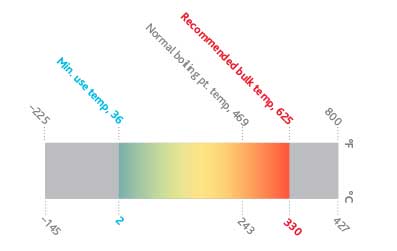Just How Heat Transfer Liquid Adds To Sustainable and Cost-Effective Workflow
In the modern-day commercial landscape, the role of warmth transfer fluids (HTFs) in promoting lasting and cost-effective operations can not be overemphasized. These liquids are critical in maximizing thermal administration systems, consequently dramatically boosting energy performance and reducing operational prices. Furthermore, the ecological benefits of sophisticated HTFs, with their high thermal stability and low toxicity, are indisputable. They not only extend system long life yet likewise add to the reduction of harmful discharges. Yet, the real capacity of HTFs is understood with the thorough option procedure, making sure compatibility and safety. However what variables should assist this critical choice?
Understanding Warmth Transfer Liquids
In the realm of thermal monitoring, warm transfer liquids (HTFs) offer as important representatives for moving thermal power from one area to one more. These liquids play a critical role in different commercial applications, including chemical processing, power generation, and HVAC systems.
The make-up of warmth transfer fluids can differ dramatically, including alternatives such as mineral oils, artificial oils, glycols, and molten salts. Each type provides unique benefits, such as boosted thermal security, low thickness, and high boiling factors, which are picked based on specific operational requirements. Furthermore, the choice of HTF influences not just the performance of warm transfer however additionally the long life and safety of the system in which it is used.
As sectors continue to introduce, the advancement of innovative HTFs, defined by their improved thermal conductivity and minimized environmental influence, is critical for fulfilling the demands of contemporary thermal monitoring obstacles.

Enhancing Power Effectiveness

Improving energy performance has come to be an extremely important concern across different industries, motivating a more detailed assessment of heat transfer fluids' duty in enhancing thermal monitoring systems. These liquids are important to preserving the preferred temperature level in procedures, thus decreasing power waste and boosting total system performance. By choosing an appropriate warm transfer fluid, markets can significantly improve their power performance, causing reduced energy consumption.

Advanced formulations of heat transfer fluids have actually been developed to hold up against extreme temperature levels while keeping security and performance. Improving energy effectiveness through optimal heat transfer liquid choice is not only a technological necessity however also an ecological crucial.
Minimizing Functional Prices
Functional expenses are a substantial consideration for markets seeking to preserve affordable advantage, and the selection of warmth transfer fluid plays a crucial role in expense administration. Selecting a proper heat transfer fluid can bring about significant cost savings by boosting system efficiency and reducing power consumption. High-performance liquids decrease thermal destruction, which in turn minimizes the frequency of fluid replacement and downtime related to upkeep, consequently reducing functional costs.
Moreover, heat transfer liquids with exceptional thermal stability and corrosion resistance prolong the lifespan of devices. This decreases the requirement for frequent repairs and replacements, which can be pricey and turbulent to operations. By buying top quality liquids, industries can achieve long-term reductions in maintenance expenses and improve the integrity of their systems.
Furthermore, progressed heat transfer liquids usually show reduced thickness at running temperature levels, which enhances pump performance and lowers power usage in fluid blood circulation. This optimization of power usage straight equates right into reduced functional prices. Lots of modern-day warm transfer liquids are crafted to run efficiently over a vast temperature variety, decreasing the requirement for numerous fluid types, thus streamlining supply needs and reducing associated costs. These variables jointly add to even more sustainable and affordable procedures.
Environmental Impact Reduction
The push towards minimizing environmental effect has acquired energy in industries leveraging warmth click for source transfer fluids. Heat transfer liquids (HTFs) play an essential duty in this shift, supplying chances to enhance energy efficiency and minimize exhausts - heat transfer fluid.
Furthermore, using innovative warmth transfer fluids adds to improved system efficiency, minimizing the total energy consumption. This reduction not just results in expense savings but likewise reduces carbon dioxide exhausts, helping in the fight versus environment adjustment. Liquids that are biodegradable and recyclable better boost sustainability efforts, as they decrease waste and promote round economic climate methods.
Furthermore, including HTFs right into closed-loop systems protects against fluid loss and contamination of the surrounding environment. This technique ensures that fluids are reused, lowering the demand for brand-new resources and limiting waste generation. By embracing these environmentally mindful strategies, industries can significantly reduce their environmental impact while preserving high functional performance, lining up with worldwide sustainability objectives and regulatory needs.
Picking the Right HTF
Picking the proper heat transfer fluid my company (HTF) is a crucial action in advancing ecological sustainability within commercial processes. The option of HTF straight affects system performance, energy consumption, and ecological influence. A perfect HTF ought to have a high thermal capability, low viscosity, and high thermal conductivity to make sure effective warmth transfer. In addition, its stability over a broad temperature level variety is critical to stop degradation, which can lead to boosted emissions and waste.
This makes sure longevity and lowers upkeep costs. The liquid needs to be non-toxic and biodegradable, reducing its eco-friendly impact and making certain compliance with ecological policies.
Final Thought

Comments on “Secret Advantages of Using a High-Performance Heat Transfer Fluid”